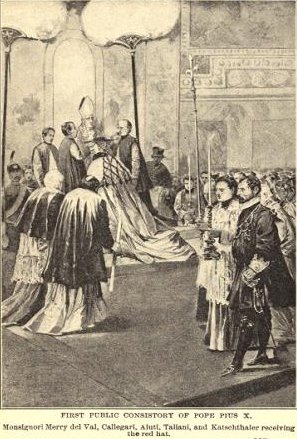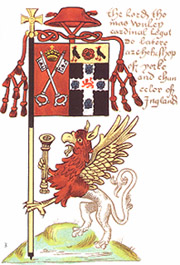|
Cardinal Campeggio
Lorenzo Campeggio (7 November 1474 – 19 July 1539) was an Italian cardinal and politician. He was the last cardinal protector of England. Life Campeggio was born in Milan, the eldest of five sons. In 1500, he took his doctorate in canon and civil law at Bologna and married Francesca Guastavillani with whom he had five children. When she died in 1509, Campeggio began an ecclesiastical career under Pope Julius II's patronage. He was soon appointed to two diplomatic missions, both against the Council of Pisa, first to the emperor Maximilian I, who gave him the Bishopric of Feltre in 1512 (held until 1520), and then in 1512–13 to the Duke of Milan. In 1513 he returned to Germany seeking a league against the Turks. Pope Leo X made him a Cardinal on 1 July 1517, and Maximilian made him Cardinal–protector of the Holy Roman Empire. On 3 March 1518 he was sent to England as part of Leo's peace policy. This gave Thomas Wolsey the chance to become legate himself by using per ... [...More Info...] [...Related Items...] OR: [Wikipedia] [Google] [Baidu] |
His Eminence
His Eminence (abbreviation H.Em. or H.E. or HE) is a style (manner of address), style of reference for high nobility, still in use in various religious contexts. Catholicism The style remains in use as the official style or standard form of address in reference to a cardinal (Catholicism), cardinal of the Catholic Church, reflecting his status as a Prince of the Church. A longer, and more formal, title is "His (or Your when addressing the cardinal directly) Most Reverend Eminence". Patriarchs of Eastern Catholic Churches who are also cardinals may be addressed as "His Eminence" or by the style particular to Catholic patriarchs, His Beatitude. When the Grand master (order), Grand Master of the Sovereign Military Order of Malta, the head of state of their sovereign territorial state comprising the island of Malta until 1797, who had already been made a Reichsfürst (i.e., prince of the Holy Roman Empire) in 1607, became (in terms of honorary order of precedence, not in the act ... [...More Info...] [...Related Items...] OR: [Wikipedia] [Google] [Baidu] |
Bishopric Of Feltre
The Italian Catholic diocese of Feltre, in the Veneto existed from 1462 to 1818. It was then united into the diocese of Belluno e Feltre. It had previously had an independent existence, up to 1197."Diocese of Feltre" ''''. David M. Cheney. Retrieved March 20, 2016"Diocese of Feltre" ''GCatholic.org''. Gabriel Chow. Retrieved March 20. 2016 History The first Bishop of |
Bishopric Of Salisbury
The Diocese of Salisbury is a Church of England diocese in the south of England, within the ecclesiastical Province of Canterbury. The diocese covers most of Dorset (excepting the deaneries of Bournemouth and Christchurch, which fall within the Diocese of Winchester), and most of Wiltshire (excepting an area in the north and Swindon). The diocese is led by Stephen Lake, Bishop of Salisbury and the diocesan synod. The bishop's seat is at Salisbury Cathedral. History Roman Catholic The Diocese of Sherborne (founded ) was the origin of the present diocese; St Aldhelm was its first Bishop of Sherborne. The Diocese of Ramsbury was created from the northwestern territory of the Bishop of Winchester in 909. Herman of Wilton was appointed bishop of Ramsbury, covering Wiltshire and Berkshire, by Edward the Confessor in 1045. In or after 1059 he was also appointed Sherborne, covering Dorset, uniting the two dioceses. In 1075 he obtained approval to move the see to Old Sarum. Disputes ... [...More Info...] [...Related Items...] OR: [Wikipedia] [Google] [Baidu] |
Pope Adrian VI
Pope Adrian VI ( la, Hadrianus VI; it, Adriano VI; nl, Adrianus/Adriaan VI), born Adriaan Florensz Boeyens (2 March 1459 – 14 September 1523), was head of the Catholic Church and ruler of the Papal States from 9 January 1522 until his death on 14 September 1523. The only Dutchman to become pope, he was the last non-Italian pope until the Polish John Paul II 455 years later. Born in the Episcopal principality of Utrecht, Adrian studied at the University of Leuven in the Low Countries, where he rose to the position of professor of theology, also serving as its rector (the equivalent of president or vice-chancellor). In 1507, he became the tutor of the future Holy Roman Emperor Charles V, who later trusted him as both his emissary and his regent. In 1516, Charles, now King of Castile and Aragon, appointed Adrian bishop of Tortosa, Spain, and soon thereafter Grand Inquisitor of the kingdoms of Aragon and Castile. Pope Leo X made him a cardinal in 1517 and after Leo's dea ... [...More Info...] [...Related Items...] OR: [Wikipedia] [Google] [Baidu] |
Papal Consistory
In the Roman Catholic Church a consistory is a formal meeting of the College of Cardinals called by the pope. There are two kinds of consistories, extraordinary and ordinary. An "extraordinary" consistory is held to allow the pope to consult with the entire membership of the College of Cardinals. An "ordinary" consistory is ceremonial in nature and attended by cardinals resident in Rome. For example, the pope elevates new cardinals to the College at a consistory; Pope Francis has called consistories for ceremonies of canonization. A meeting of the College of Cardinals to elect a new pope is not a consistory, but a conclave. History The term ''consistory'' comes from the la, con-sistere; "stand together".''Papal Consistory'' by Kevin Knight (Catholic Encyclopedia, 2009) Early popes conferred with their Roman presbytery which included ... [...More Info...] [...Related Items...] OR: [Wikipedia] [Google] [Baidu] |
Humanism
Humanism is a philosophical stance that emphasizes the individual and social potential and agency of human beings. It considers human beings the starting point for serious moral and philosophical inquiry. The meaning of the term "humanism" has changed according to the successive intellectual movements that have identified with it. During the Italian Renaissance, ancient works inspired scholars in various Italian cities, giving rise to a movement now called Renaissance humanism. With Enlightenment, humanistic values were re-enforced by the advances in science and technology, giving confidence to humans in their exploration of the world. By the early 20th century, organizations solely dedicated to humanism flourished in Europe and the United States, and have since expanded all over the globe. In the current day, the term generally refers to a focus on human well-being and advocates for human freedom, autonomy, and progress. It views humanity as responsible for the promotio ... [...More Info...] [...Related Items...] OR: [Wikipedia] [Google] [Baidu] |
Johann Goritz
Johann, typically a male given name, is the German form of ''Iohannes'', which is the Latin form of the Greek name ''Iōánnēs'' (), itself derived from Hebrew name ''Yochanan'' () in turn from its extended form (), meaning "Yahweh is Gracious" or "Yahweh is Merciful". Its English language equivalent is John. It is uncommon as a surname. People People with the name Johann include: A–K * Johann Adam Hiller (1728–1804), German composer * Johann Adam Reincken (1643–1722), Dutch/German organist * Johann Adam Remele (died 1740), German court painter * Johann Adolf I, Duke of Saxe-Weissenfels (1649–1697) * Johann Adolph Hasse (1699-1783), German Composer * Johann Altfuldisch (1911—1947), German Nazi SS concentration camp officer executed for war crimes * Johann Andreas Eisenmenger (1654–1704), German Orientalist * Johann Baptist Wanhal (1739–1813), Czech composer * Johann Bernhard Fischer von Erlach (1656–1723), Austrian architect * Johann Bernoulli (1667–1748), Swis ... [...More Info...] [...Related Items...] OR: [Wikipedia] [Google] [Baidu] |
Treaty Of London (1518)
The Treaty of London in 1518 was a non-aggression pact between the major European states. The signatories were Burgundy, France, England, the Holy Roman Empire, the Netherlands, the Papal States and Spain, all of whom agreed not to attack one another and to come to the aid of any that were under attack. The treaty was designed by Cardinal Wolsey and so came to be signed by the ambassadors of the nations concerned in London. originally called for a five-year peace while the monarchs of Europe helped him fight back the rising power of the |
Papal Legate
300px, A woodcut showing Henry II of England greeting the pope's legate. A papal legate or apostolic legate (from the ancient Roman title ''legatus'') is a personal representative of the pope to foreign nations, or to some part of the Catholic Church. He is empowered on matters of Catholic faith and for the settlement of ecclesiastical matters. The legate is appointed directly by the pope—the bishop of Rome and head of the Catholic Church. Hence a legate is usually sent to a government, a sovereign or to a large body of believers (such as a national church) or to take charge of a major religious effort, such as an ecumenical council, a crusade to the Holy Land, or even against a heresy such as the Cathars. The term ''legation'' is applied both to a legate's mandate and to the territory concerned (such as a state, or an ecclesiastical province). The relevant adjective is ''legatine''. History 200px, Cardinal Thomas Wolsey, papal legate to England during the reign of Hen ... [...More Info...] [...Related Items...] OR: [Wikipedia] [Google] [Baidu] |
Thomas Wolsey
Thomas Wolsey ( – 29 November 1530) was an English statesman and Catholic bishop. When Henry VIII became King of England in 1509, Wolsey became the king's almoner. Wolsey's affairs prospered and by 1514 he had become the controlling figure in virtually all matters of state. He also held important ecclesiastical appointments. These included the Archbishopric of York—the second most important role in the English church—and that of papal legate. His appointment as a cardinal by Pope Leo X in 1515 gave him precedence over all other English clergy. The highest political position Wolsey attained was Lord Chancellor, the king's chief adviser (formally, as his successor and disciple Thomas Cromwell was not). In that position, he enjoyed great freedom and was often depicted as an ''alter rex'' ("other king"). After failing to negotiate an annulment of Henry's marriage to Catherine of Aragon, Wolsey fell out of favour and was stripped of his government titles. He retreated to ... [...More Info...] [...Related Items...] OR: [Wikipedia] [Google] [Baidu] |
Holy Roman Empire
The Holy Roman Empire was a Polity, political entity in Western Europe, Western, Central Europe, Central, and Southern Europe that developed during the Early Middle Ages and continued until its Dissolution of the Holy Roman Empire, dissolution in 1806 during the Napoleonic Wars. From the accession of Otto I in 962 until the twelfth century, the Empire was the most powerful monarchy in Europe. Andrew Holt characterizes it as "perhaps the most powerful European state of the Middle Ages". The functioning of government depended on the harmonic cooperation (dubbed ''consensual rulership'' by Bernd Schneidmüller) between monarch and vassals but this harmony was disturbed during the Salian Dynasty, Salian period. The empire reached the apex of territorial expansion and power under the House of Hohenstaufen in the mid-thirteenth century, but overextending led to partial collapse. On 25 December 800, Pope Leo III crowned the List of Frankish kings, Frankish king Charlemagne as Carolingi ... [...More Info...] [...Related Items...] OR: [Wikipedia] [Google] [Baidu] |




